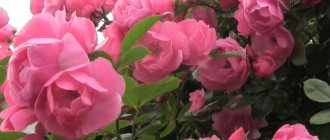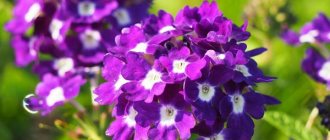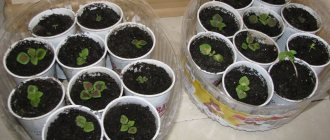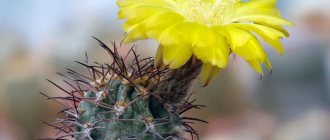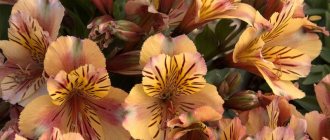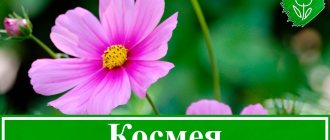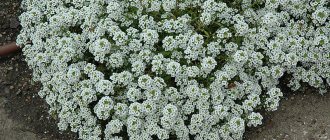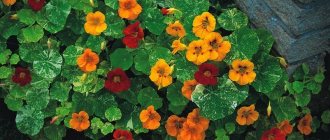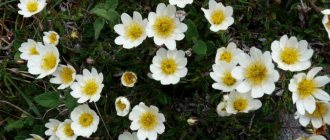Description of rock alyssum
This herbaceous plant is found in the mountainous regions of Europe and the shores of the Mediterranean Sea. A flowering perennial up to 30 cm high, it is densely covered with yellow four-petaled flowers collected in brushes. A bushy plant with semi-lignified shoots blooms in early spring. Rock alyssum has pubescent thin leaves of a bluish-gray hue. The delicate aroma of the plant is attractive to bees. By autumn, small flat achenes ripen in the pods. The root system of the crop is compact
General characteristics
Rocky alyssum is a perennial, reaching 30 cm in height. It grows in the form of hemispherical bushes 40 cm in size. The stems are highly branched and become woody at the base.
The leaves are elongated, pubescent, gray in color. The flowers are small, bright yellow, bloom in inflorescences. The flowers have a strong honey aroma that attracts bees and other pollinators.
The flower consists of 4 sepals and petals, arranged in a checkerboard pattern. Pollination occurs with the help of insects. In autumn, the plant produces fruits in the form of pods filled with seeds.
In nature, rock alyssum is found in Europe and southern Siberia. Flowering begins in spring and lasts for 40 days. At the end of summer, re-formation of inflorescences is possible.
The flower has been known since the 18th century. Its composition has not been fully studied, but the seeds contain organic acids and oils. The leaves and inflorescences of the plant have a diuretic and laxative effect.
The plant is used for decorating single and multi-flowered flower beds and borders. Ideal for decorating alpine slides. The flower tolerates cold temperatures down to -15°C, but is demanding of good lighting.
Popular varieties
Some types of alyssum bloom in shades of pink and purple. Rock alyssum flowers are predominantly yellow. Even the names of the varieties contain references to the golden shades of lush flowering.
Alyssum rocky Golden wave
The Golden Wave rock alyssum bushes live up to their name. Many bright inflorescences of golden yellow color cover lush bushes with a diameter of about 40 cm and form a wavy cushion. The height of this variety of alyssum can reach no more than 25 cm. When grown as seedlings, rocky alyssum Golden Wave blooms a little later than a month after placement in the flowerbed. When favorable conditions are created, flowering lasts almost all summer. The silvery foliage is no less decorative than the flowers.
Alyssum rocky Gold placer
Gardeners classify the Golden Placer variety as a ground cover. Lush bushes about 15-20 cm high are covered with yellow flowers. The strongly branched plant quickly grows throughout the entire space. The Golden Placer blooms from May to the end of June. By creating optimal conditions and timely pruning, you can get secondary flowering closer to autumn.
Alyssum rocky Inca gold
A perennial covered with many yellow fragrant flowers, it has small inflorescences. Strongly branched bushes with bluish pubescent small leaves are used as a ground cover plant.
Alyssum rocky Mountain gold
The low-growing perennial variety Mountain Gold forms a bright carpet in the flowerbed. The bushes of a flowering plant with lodging shoots are covered with small lush inflorescences until frost.
Alyssum rock Aphrodite
One of the few varieties of rock alyssum, whose flowers are purple, red and pinkish, is grown as an annual crop. The plant blooms from June to October, and in some regions even longer. The low-growing, branched plant has many simple flowers in lush clusters.
Alyssum rocky yellow
One of the shortest varieties of rock alyssum, the height of the bushes rarely reaches more than 10 cm. A branched plant with recumbent and ascending shoots develops well in sunny areas with rocky, acidic soil.
Nuances
There are no special nuances in growing alyssum. Ground cover bushes planted in a sunny corner of the garden bloom profusely all summer. Under unfavorable weather conditions, plant development may stop. With the help of a simple technique they are reanimated, and flowering resumes.
See also
How to dry lavender at home, timing of collection and preparationRead
How to prolong flowering
Alyssum bushes, weakened by heat and drought, are being revived. First, water, then cut out some of the shoots. Leave 5-6 pieces per bush. Prepare liquid fertilizer:
- water - 10 l;
- urea - 1 tbsp. l.;
- "Agricola-7" - 1 tbsp. l.
After restoration measures, the flowering of alyssum resumes and lasts until frost.
Features of winter planting
Winter hardiness of perennials is average. To protect against frost, alyssum bushes are covered with fallen leaves for the winter. In winter, snow is thrown onto the flowerbed.
Landing Features
Gardeners consider rock alyssum an unpretentious herbaceous plant suitable for open ground. It can grow in one place for several years without transplantation, requiring almost no care. But in order to create a neat flowering flowerbed that will delight you all summer, you need to follow some rules.
Site selection and preparation
To plant rock alyssum, you need to choose a place that is illuminated most of the day. In the southern regions, it is possible to plant flowers in partial shade. In nature, rock alyssum grows on mountain slopes. Therefore, this species can be placed on rocky soil heated by the sun.
Rock alyssum does not have any special requirements for the composition of the soil. But long-term lush flowering can only be achieved on loose, fertile soils.
Important! Rocky alyssum does not tolerate close groundwater.
The area for planting plants must be well drained. Stagnation of water negatively affects the condition of flowers and shoots.
Growing from seeds
Seeds for growing golden rock alyssum are collected in the fall. In regions with a cool climate, it is recommended to cultivate alyssum through seedlings. In the south, you can sow seeds in the ground after the snow has melted and the area has warmed up.
To germinate the crop, the soil must be light, loose and fertile. Small seeds do not need to be soaked. Alyssum is sown for seedlings in March and April, depending on the region. Although this crop is frost-resistant, frost can be fatal for young seedlings.
Seed sowing algorithm:
- Place a small layer of drainage mixture on the bottom of the seedling box.
- Pour soil from a mixture of turf soil, sand and humus.
- Place the seeds at intervals of 1 - 1.5 cm
- Apply a layer of soil about 1 cm.
- Pour over warm water.
- Cover with glass or film.
Until the seeds hatch, the box can be kept in a dark, warm place. The minimum temperature for seed germination should be about 15 degrees Celsius. Be sure to ventilate the container daily to avoid mold growth.
Shoots appear in about a week. After a pair of true leaves have formed, the seedlings can be planted in separate containers. Some gardeners believe that picking is harmful to young plants. Dense seedlings are thinned out at a distance of 10 - 12 cm.
Important! Planting in open ground can be done when a stable air temperature is above 10 degrees Celsius.
In the southern regions with early warm spring, alyssum can be sown directly in open ground. When growing by seedlings, it is not necessary to pick plants for growing. After the leaves appear, the seedlings can be planted in a permanent place.
Sowing seeds in open ground is almost no different from growing seedlings. Instead of picking, the seedlings need to be thinned out twice until the required distance between the bushes is achieved.
Cuttings and dividing the bush
In summer, alyssum is propagated by cuttings. To do this, shoots about 10–15 cm high are cut and rooted in loose, moist soil. To speed up root formation, you can soak the cuttings in Kornevin (Heteroauxin, Kornerost) or any other complex preparation.
Alyssum cuttings take root better in greenhouse conditions. You can use a greenhouse on the site or an indoor mini-greenhouse for propagating flower crops. The main thing is to observe measures to protect seedlings from wind and drying out of the soil.
The root system of the cuttings is formed within a month and a half, after which the alyssum can be planted in a permanent place in open ground. If there is more than a month left before the onset of frost, the young plants will bloom next spring.
The distance between rocky alyssum bushes when planting in a permanent place depends on the selected variety. It should be taken into account that most varieties form fairly voluminous bushes. It is recommended to maintain an interval of about 30 - 40 cm. Density of plantings can lead to a decrease in the splendor of flowering and the development of fungal diseases.
Perennial rock alyssum can be grown on the site by dividing the bush. The procedure is carried out in early spring after the first greens hatch. It is necessary to dig the plant out of the soil and cut it into the required number of parts with a sharp knife.
Plant the plants in the usual way in a fertile, well-drained area. Until the seedlings are established in their new location, be sure to provide them with timely watering and shade in sunny weather.
Review Reviews
When keeping alyssum, flower growers are attracted by its decorative properties and pleasant smell, which spreads throughout the entire garden. Flower owners also like the opportunity to create the most unusual compositions with it. According to summer residents, various varieties bloom quite well and luxuriantly, especially with abundant watering. I also like the fact that alyssum grows very quickly, as well as the excellent ripening of its seeds. Lovers of these flowers often share seed material with each other.
There are also disadvantages of growing alyssum. So, some gardeners, even experienced ones, try to grow a flower by sowing it in open ground, but for several years this does not work. In their opinion, the seeds do not have good germination. Other owners explain this phenomenon by extreme heat or heavy soil and recommend trying planting using seedlings, observing two main conditions - loose soil and timely watering.
You can learn how to get alyssum to bloom in the video below.
Rules of care
Growing rock alyssum is not particularly difficult. Systematic watering and fertilizing will help achieve lush flowering. To re-bloom the flower bed, pruning is necessary.
Watering
In dry weather, plants should be watered at least 1-2 times a week. It is important to normalize the amount of moisture. Overwatering can lead to the development of diseases. Lack of moisture reduces the number of flowers, affecting the decorativeness of plantings.
The need for moisture is determined by the condition of the soil at a depth of 5 - 6 cm. Watering is carried out at the root and by sprinkling - in the early morning or after a decrease in solar activity in the evening.
Top dressing
If the soil on the site is sufficiently fertile, then fertilizing can be done in the second year in the spring, before flowering begins. It is necessary to apply nitrogen fertilizers or a ready-made complex for flower crops. This will ensure the growth of green mass and increase the number of flowers on young shoots.
When growing a perennial in one place for a long time, the number of feedings can reach up to four per season. Nitrogen is added in spring. In summer, you can feed alyssum with potassium and phosphorus fertilizers.
The interval between feedings should be about 10 days. Fertilizers are applied in liquid form after preliminary watering. This method allows nutrients to be better distributed in the soil without damaging the root system.
Trimming
In the spring, it is necessary to carry out sanitary pruning of old perennial shoots. At the same time, remove diseased, damaged and weak parts. For heavily overgrown bushes, carry out shaping in order to maintain a neat appearance of the plantings.
To achieve a second flowering, shoots are shortened by several centimeters in summer to stimulate the development of flower stalks.
Disease and pest control
Alyssum rocky suffers greatly from cruciferous flea beetle. This small insect can destroy all foliage, especially in young plantings. The pest is eliminated using means that are usually used to protect all crops of the cruciferous family (cabbage).
Immediately after planting the seedlings, you can spray the plants with Inta-Vir solution. To do this, you need to dilute 1 tablet in 10 liters of water and moisten the bushes generously. Treatment is carried out in the evening, in calm, dry weather.
To combat cruciferous flea flea, you can use a solution of drugs:
- based on alpha-cypermethrin - Tsunami, Fastak, Accord;
- based on imidocloprid - Borey, Imidalit;
- based on thiamethoxam - Aktara.
You can also use folk remedies against harmful insects. Plants are treated against fleas with infusion or dry dust of tobacco, chamomile and wood ash.
You can often find caterpillars in plantings that feed on leaf tissue, turning ornamental greenery into skeletons. Manual collection of the pest is not able to provide long-term plant protection. To prevent the destruction of the flower garden, traps are placed around the plantings for butterflies, which lay their eggs on the leaves of alyssum. You can use decoys, which are made from the shells of chicken eggs, or hang sticky poisonous traps during the period when insects fly out.
Important! When choosing a product to protect rock alyssum against pests, you should take into account the harm caused by chemicals to humans and the environment.
If there is an excess of moisture, rock alyssum can suffer from brown rot and powdery mildew, which is expressed in darkening and drying of the vegetative parts of the plant. Powdery mildew on the leaves looks like a grayish coating. If a flower garden is damaged, it is necessary to treat the plants with standard fungicides. To prevent flowers from becoming infected with fungal diseases, it is necessary to strictly monitor the humidity of the area. It is imperative to destroy weeds, which are often the source of the spread of diseases of cultivated plants.
Preparing for winter
Alyssum easily tolerates autumn temperature drops. It can preserve foliage even in frosts of about 5 degrees Celsius. But in winter the plant requires light shelter.
Alyssum does not need autumn pruning. You can clear the bushes of damaged shoots, but you should not cut them off completely.
Before the onset of winter, plantings can be covered with dry leaves or pine spruce branches. In winter, it is important to ensure that the snow cover on the site is high enough. This is quite enough for the alyssum to quickly grow in spring and delight you with lush flowers.
4.Varieties:
4.1. Rocky alyssum - Alyssum saxatile
Evergreen perennial plants, originating from Central and south-eastern Europe, do not exceed 30 cm in height. The leaves are gray-green, up to 12 cm long. In spring or early summer, the plants form apical inflorescences containing many yellow bright flowers. The flowering period is quite long - the bushes are in bloom for one to one and a half months.
4.2. Sea alyssum - Alyssum maritimum
An evergreen perennial from Southern Europe with thin, stiff, often lodging stems and narrow, green leaves. During the flowering period, small inflorescences consisting of pink, salmon, purple, white or yellow flowers form at the tops of the stems. The plant can throw out buds from June to October, and cutting off the faded inflorescences can cause re-blooming during the season. Alyssum flowers emit an extremely pleasant honey aroma.
4.3. Alyssum Wonderland
Miniature plants that often do not exceed 10 centimeters in height. They have oblong light green leaves. During the summer months, the plants produce terminal inflorescences consisting of small, 4-petalled, white, lavender, purple, pink, or burgundy flowers. The flowering is so abundant that the buds completely hide the foliage. The duration of flowering can reach 50 - 70 days and all this time the plants emit a pleasant sweetish smell.
4.4.Alyssum Easter Bonnet
Medium-sized variety - bushes reach a height of 10 to 25 cm. The plant has elegant, fragrant, small flowers in shades of white, yellow, lilac, pink, crimson, purple, salmon. A distinctive feature of this variety is its very abundant and long-lasting flowering.
4.5.Mountain alyssum - Alyssum montanum
Compact evergreen perennials with erect, thin, stiff stems. The plant has silver-green or green, oblong leaves. Often this miniature variety does not exceed 10 - 15 cm in height. Flowering is early - the first buds may appear in mid-spring. The flowers are golden orange or yellow and cover the plants so abundantly that they completely hide the foliage.
You might also be interested in:
Ageratum
Verbena
Purslane
Lobelia
Application in landscape design
Rock alyssum looks beautiful as a ground cover plant in flower beds. A bright yellow blanket of flowers combines with taller ornamental perennials and annuals.
Alyssum rock is ideal for alpine slides and borders along paths. It will do a great job decorating rocky areas.
Reproduction
Alyssum is propagated by seeds and vegetatively.
Cuttings
Rooting of cuttings is done in the summer. Prepare a small ridge and fill it with fertile soil. 10 cm long apical cuttings are planted. They are protected from the sun for the first week. Care consists of regular watering.
Dividing the bush
This vegetative propagation method is rarely used in practice. The bush is dug up in the fall. Place it in a container. Store in the cellar until spring. With the onset of warm days, they divide it into several parts. At least 4 shoots are left in each division. Planted in the flowerbed on the same day.
Collecting seeds
The seeds ripen at the end of September. Dry inflorescences must be collected from healthy plants before October. Seeds are dried in a warm room before being sent for storage.
Pest and disease control
If the soil of alyssum is constantly damp and wet, rotting processes begin. Late blight or brown rot almost irrevocably affects its roots. It is necessary to remove all damaged areas as quickly as possible and spray the seedlings with fungicides.
Another common disease of alyssum is true or downy mildew. Bordeaux mixture or special medicinal preparations help well. But it is impossible to get rid of the viral mosaic, so diseased plants will have to be removed.
The main and most dangerous pest of alyssum is the cruciferous flea beetle, which is very difficult to remove. Only the strongest bushes will survive a full treatment with vinegar in several passes. Caterpillars, moths and cabbageweeds also spoil flowers, but they are easier to deal with.
Photo: attuale.ru
